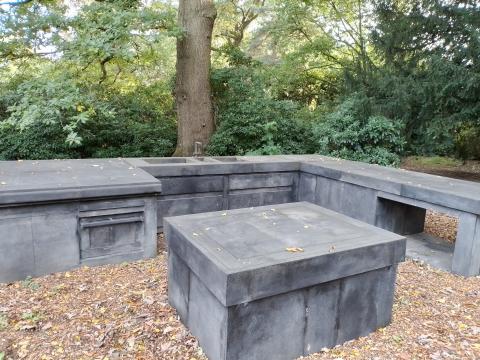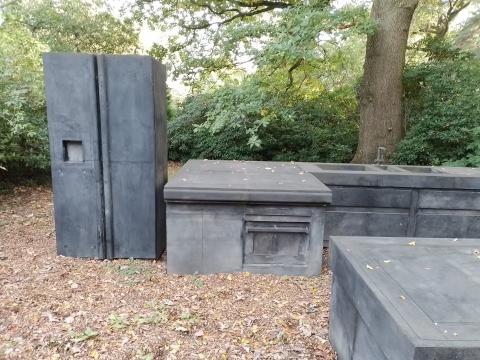Standard Kitchen (2017)

João Vasco Paiva created Standard Kitchen in 2017 which is now displayed at the Yorkshire Sculpture Park. He collaborated with artisans in East Bali, who used the traditional method of carving large Batu Candi, a lava stone used in temples, shrines and other religious constructions. The lava stone was shaped into the form of a life-sized replica of a modern kitchen to consider the processes and spaces that are a part of everyday life.
The subject matter and material of the work are in stark contrast to their leafy surroundings but are easily identifiable and invite interaction among those who come to inspect. The work appears in the landscape like a piece of archaeology. In the way that we learn about the lives of people before us from their surviving artefacts, such as pottery and ruins, future researchers might find Standard Kitchen and have insight into the typical lifestyle and ritual of those living in the 21st century and their domestic spaces.

Paiva, who was born in 1979 at Coimbra, is a Portuguese contemporary artist who studied at Porto Arts Institute in Portugal before moving to Hong Kong in 2006 to complete his postgraduate degree in Creative Media. Considered one of Hong Kong's leading emerging artists, his work reflects urban environments and contemporary archaeology and uses a variety of media, many of which are synonymous with the urban landscape, such as concrete, plaster, tarpaulin, resins, silicone, and aluminium. Playing with the associations and common uses we ascribe to these materials is an important and recurring aspect of Paiva's practice.
The human form is largely absent from the artist's work; instead, he uses the traces left by humanity as a way to evaluate its purpose. The artist states that “How space is designed says more about people than if I include the human body." In Standard Kitchen, the viewer is implicitly invited to include themselves within Paiva's work, occupying the familiar kitchen space in a new setting, and to consider the implications of the competing semantic devices in his practice.
How we use our space, our time, our money and our minds all indicate the kind of people we are. The prominence we give to Jesus Christ bespeaks the quantity and quality of our faith. If the rooms of our house, the contents of our wardrobes and the material in our top drawers were moved into an acre of parkland for all to rummage and sift, what might people conclude?
- Log in to post comments


 Sunday Worship 10.45am & 6.00pm
Sunday Worship 10.45am & 6.00pm